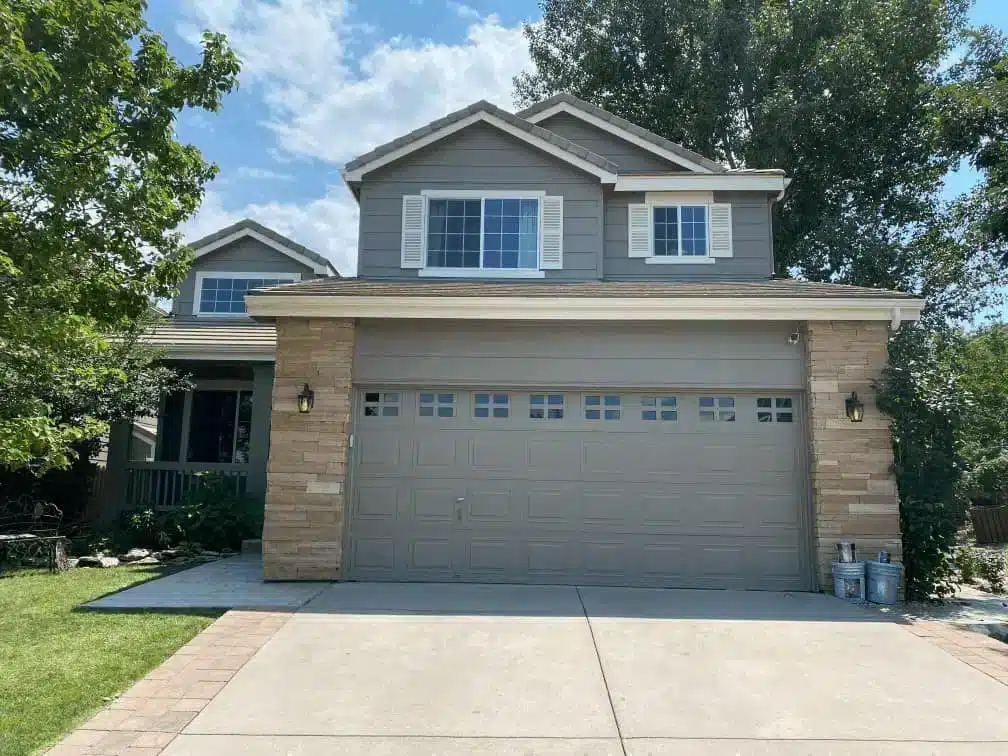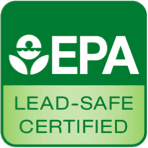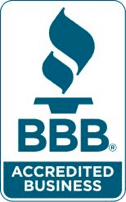Every successful painting job begins with understanding your paint options and how each type of paint performs. The choice between acrylic and alkyd affects everything from application ease to durability. Different formulations serve unique purposes and can help you achieve outstanding results. This guide explores the differences between acrylic and alkyd paint to guide your paint selection.
What is Acrylic Paint?
Acrylic paint is a water-based coating that combines colored pigments with synthetic polymer particles to create a versatile painting medium. When applied, the water evaporates and leaves behind a flexible film that bonds permanently to surfaces. The paint also contains stabilizing agents and additives that prevent separation during storage.
This type of paint works well for artistic projects, such as murals or decorative accents, as well as exterior and interior walls. These are the main characteristics of acrylic paint:
- Fast drying time: Light coats dry in minutes, while heavier applications cure completely within hours, speeding up the painting process.
- Low odor and low VOCs: These paints give off minimal fumes and release fewer toxic chemicals, making them suitable for indoor painting without extensive ventilation.
- Excellent color retention and UV resistance: Pigments stay vibrant and resist fading because the polymer base naturally blocks UV rays and prevents color deterioration.
- Flexibility: The dried film remains elastic, which prevents cracks from forming when surfaces expand or contract with weather changes.
- Easy clean up: Acrylic paint is water-based, so brushes and other tools can easily be cleaned with water once you are done.
What is Alkyd Paint?
Alkyd paint uses synthetic resins made from combining alcohol and acid compounds with oil-based materials to create a strong binding system. These resins mix with chemical solvents and drying accelerators that help form an extremely durable finish. Professionals often choose alkyd paint for doors, trim work, and furniture because it produces a smooth, long-lasting surface.
The characteristics that make alkyd paint distinctive are:
- Slower drying time allows for a smoother finish: Alkyd paint stays wet for longer, which allows it to be blended evenly, hiding brush marks and delivering a glass-like, professional appearance.
- Strong adhesion and enamel-like hardness: This paint grips surfaces tightly and hardens into a tough shell that resists scratches, stains, and daily wear.
- Higher VOC content and more pungent odor: Alkyd formulations release strong chemical vapors during application, requiring good ventilation and safety measures.
- Excellent leveling but prone to yellowing over time: While the paint spreads perfectly smooth, it may gradually develop a yellow cast as the resins age, particularly noticeable in light colors.
- Difficult cleanup: Alkyd paint must be cleaned off of brushes and other tools with mineral spirits or paint thinner.
Side-by-Side Comparison: Acrylic vs. Alkyd Paint
Making the right paint choice depends on knowing how these two options perform. Alkyd paint and acrylic painthave distinct properties that will affect your project:
Composition and Environmental Impact
Alkyd paint consists of alkyd resin mixed with organic solvents and pigments in a ready-to-use formula. The solvent-based chemistry releases harmful VOCs into the air during application and curing. Acrylic paint uses acrylic resin with water as the main carrier, though some types require curing agents for specific applications. This water-based method cuts down on toxic emissions.
Performance and Durability
Acrylic paint maintains its original color and gloss even after years of UV exposure while resisting damage from acids, alkalis, and harsh chemicals. The flexible film adapts to temperature changes without cracking or peeling away from surfaces. Alkyd paint sticks strongly to surfaces and resists scratches in the indoor environments where physical durability matters most. However, sun exposure gradually turns alkyd paint yellow and causes it to lose its protective qualities faster than acrylic alternatives.
Drying and Curing Times
Acrylic paint dries to the touch within 30 minutes because the water evaporates quickly from the surface. This rapid curing time allows painters to apply second coats the same day and finish projects faster. Alkyd paint takes at least 3 hours to dry because its solvents need more time to evaporate completely. Longer drying periods and a need for proper ventilation can stretch construction schedules when conditions aren’t perfect.
Finish and Aesthetic Qualities
Acrylic paint produces vibrant colors that stay bright for years without dulling or changing shade. Alkyd paint initially creates smooth, glossy surfaces but slowly turns yellow, especially in white and light shades. The paint’s flexible nature lets it move with building materials without cracking as temperatures change.
Cost Considerations
Acrylic paint costs more initially but usually saves you money in the long term by delivering long-lasting results. Alkyd paint attracts buyers because of its lower upfront prices, though its shorter lifespan may mean higher total costs eventually.
Cleanup and Safety
Water-based acrylic paint can be cleaned off of tools with soap and water and creates minimal odors. Alkyd paint can only be cleaned with chemical solvents and produces strong smells. These toxic vapors can cause health problems in poorly ventilated spaces or for sensitive individuals.
The Pros and Cons of Acrylic Paint
Here are the main benefits and drawbacks of using acrylic paint for your projects:
Pros
- Generates very little smell and emits minimal VOCs compared to other paint types
- Dries quickly, allowing you to complete projects faster
- Retains its original colors well and resists fading even when exposed to light over time
- Remains flexible after drying, preventing cracks when surfaces expand or contract with weather changes
Cons
- Offers less protection against wear compared to oil-based paints, especially on trim and cabinet surfaces
- Usually needs an undercoat when applied to slick surfaces
- Creates visible brush patterns more easily since it dries quickly
Pros and Cons of Alkyd Paint
Here are the primary advantages and disadvantages of choosing alkyd paint:
Pros
- Delivers exceptional toughness that withstands scratches and high traffic better than water-based options
- Creates a sleek, glossy surface that flows smoothly and reduces the appearance of brush strokes
- Adheres extremely well to wood and metal without requiring a primer coat first
Cons
- Releases high amounts of toxic fumes and produces strong chemical smells that require ventilation
- Takes significantly more time to dry to the touch and may need up to a month to fully harden
- Develops a yellowish tint over time, especially noticeable in white and pale color choices
- Requires harsh chemical cleaners for washing brushes and spills, making cleanup more dangerous and complicated
How to Choose Between Acrylic and Alkyd Paint for Your Project
The choice between alkyd paint and acrylic paint becomes clear when you work through these important considerations.
Surface Type and Location
First, examine what you’re painting and where it’s located in your home. Smooth, properly prepared surfaces work well with acrylic paint since the paint forms a protective coating on top. Older or slightly damaged surfaces often need alkyd’s deeper penetration to create strong bonds and fill minor imperfections. Consider the surface’s exposure to moisture, sunlight, and temperature changes when making your choice.
Room Use and Traffic
Busy areas like hallways, kitchens, and children’s rooms need alkyd’s tough finish to handle constant touching and cleaning. It’s also ideal for trim, baseboards, doors, and cabinets that see heavy use. Quiet spaces such as adult bedrooms and formal dining rooms work well with acrylic paint since they don’t face heavy wear. The difference becomes obvious when you think about how often each surface gets bumped, wiped, or handled.
Desired Finish and Longevity
Acrylic keeps colors looking fresh longer and flexes with temperature changes without developing cracks. Alkyd blends out beautifully to create glass-smooth surfaces that look professionally sprayed even when brushed on.
Environmental and Health Concerns
Safety and comfort in your living space influence which paint makes sense for your family. Acrylic paint produces milder odors that clear up quickly, so you can return to normal routines sooner after painting. Alkyd odors need more time and ventilation to dissipate properly, which may not be convenient. Water-based alkyd formulations split the difference by offering alkyd performance with gentler fumes.
Budget and Schedule Constraints
Balance what you can spend now against how quickly you need the project finished. Alkyd paint costs less initially but adds time to your project since each coat needs longer to dry properly. Acrylic paint may cost more upfront, but it lets you complete the job faster and use the space sooner.
Climate and Humidity Considerations
Look at your local weather patterns and where the painted surface will be located long-term. Acrylic paint works better in areas with changing temperatures and humidity levels as it stays flexible and resists weather damage. Alkyd performs best indoors where the temperature stays steady and moisture levels remain controlled. If you must paint during challenging weather, acrylic offers more forgiving application conditions.
Final Thoughts
Knowing when to use acrylic vs. alkyd paint saves you time and money on your painting projects. Acrylic is ideal for most walls and outdoor surfaces because it stays flexible and maintains its color, but alkyd provides a smooth, enduring finish on cabinets and trim that can withstand daily use. Our skilled Boise-based painters guide you in selecting the right paint and deliver professional interior and exterior painting services tailored to your needs. Call us today for a free estimate!











